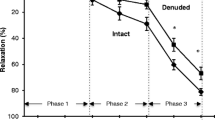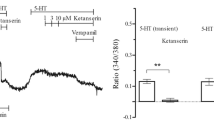Abstract
Since adenosine A1 receptors activate phospholipase C (PLC) in DDT1 MF-2 smooth muscle cells we have examined whether phospholipase D (PLD) and protein kinase C (PKC) activities are also increased. The formation of diacylglycerol was also measured. PKC activity was determined by measuring the phosphorylation of two peptide substrates after rapidly permeabilizing the cells. PLD activity was determined by measuring the formation of phosphatidylethanol.
N6-cyclopentyladenosine, a selective adenosine A1 receptor agonist (100 nM) and bradykinin (1 μM) both stimulated the formation of diacylglycerol. The activation was biphasic with a rapid, transient increase (within 1 min) followed by a second increase. N6-cyclopentyl-adenosine increased the activity of PKC (EC50 5.6 nM) and PLD (EC50 18.7 nM). This was blocked by treatment of cells with pertussis toxin or the adenosine A1 receptor selective antagonist, 8-cyclopentyl-1,3-dipropylxanthine. Ki values (3 nM for PKC; 0.1 nM for PLD) were consistent with responses mediated via adenosine A1 receptors. Bradykinin (1 μM) also increased PKC and PLD activity, but these responses were insensitive to pertussis toxin treatment. The activation of PKC by N6-cyclopentyladenosine or bradykinin was transient, reaching a maximum at 1–2 min, and was preceded by increases in the formation of diacylglycerol. When adenosine A1 and bradykinin receptors were activated simultaneously, a synergistic activation of PKC was seen. There was no synergistic effect on PLD activity.
In summary, the present study shows that activation of adenosine receptors of the At subtype increases PKC and PLD activity. Simultaneous activation of adenosine A1 and bradykinin receptors causes a synergistic increase in PKC.
Similar content being viewed by others
References
Adeyemi EO, Savage AP, Bloom SR, Hodgson HJF (1990) Somatostatin inhibits neutrophil elastase release in vitro. Peptides 11:869–871
Assender JW, Kontny E, Fredholm BB (1994) Expression of protein kinase C isoforms varies with state of differentiation in smooth muscle cells. FEBS Lett 342:76–80
Balmforth AJ, Parkinson FE, Altiok N, Fredholm BB (1992) Identification of a B2-bradykinin receptor linked to phospholipase C and inhibition of dopamine stimulated cyclic AMP accumulation in the human astrocytoma cell line D384. NaunynSchmiedeberg's Arch Pharmacol 346:303–310
Belardinelli L, Giles WR, West A (1988) Ionic mechanisms of adenosine actions in pacemaker cells from rabbit heart. J Physiol 405:615–633
Belardinelli L, Isenberg G (1983) Isolated atrial myocytes: adenosine and acetylcholine increase potassium conductance. Am J Physiol 244:H734-H737
Berridge MJ (1993) Inositol trisphosphate and calcium signalling. Nature 361:315–325
Billah MM (1993) Phospholipase D and cell signaling. Curr Opin Immunol 5:114–123
Billah MM, Anthes JC (1990) The regulation and cellular functions of phosphatidylcholine hydrolysis. Biochem J 269:281–291
Billah MM, Eckel S, Mullmann TJ, Egan RW, Siegel MI (1989) Phosphatidvlcholine hvdrolvsis by phospholipase D determines phosphatidate and diglyceride levels in chemotactic peptide-stimulated human neutrophils. Involvement of phosphatidate phosphohydrolase in signal transduction. J Biol Chem 264:17069–17077
Bligh EG, Dyer WJ (1959) A rapid method of total lipid extraction and purification. Can J Biochem Physiol 37:911–917
Bonser RW Thompson NT (1992) Phosphatidylcholine hydrolysis by phospholipase C and D. In: Milligan G (ed) Signal transduction. A practical approach. IRL Press, Oxford, pp 123–151
Bourgin S, Grinstein S (1992) Peroxides of vanadate induce activation of PLD in HL-60 cells: role of tyrosine phosphorylation. J Biol Chem 267:11908–11916
Cockcroft S (1992) G-protein-regulated phospholipases C, D and A2-mediated signalling in neutrophils. Biochim Biophys Acta 1113:135–160
Dolphin AC, Forda SR, Scott RH (1986) Calcium-dependent currents in cultured rat dorsal root ganglion neurones are inhibited by an adenosine analogue. J Physiol 373:47–61
Eibl H, Kovatchev S (1981) Preparation of phospholipids and their analogs by phospholipase D. Methods Enzymol 72:632–639
Fredholm BB, Dunwiddie TV (1988) How does adenosine inhibit transmitter release? Trends Pharmacol Sci 9:130–134
Freissmuth M, Schütz W, Linder ME (1991) Interactions of the bovine brain A1-adenosine receptor with recombinant G protein alpha-subunits. Selectivity for rGi alpha-3. J Biol Chem 266:17778–17783
Gerwins P (1993) Modification of a competitive protein binding assay for determination of inositol 1,4,5-trisphosphate. Anal Biochem 210:45–49
Gerwins P, Fredholm BB (1991) Glucocorticoid receptor activation leads to up-regulation of adenosine A1 receptors and down-regulation of adenosine A2 responses in DDT1 MF-2 smooth muscle cells. Mol Pharmacol 40:149–155
Gerwins P, Fredholm BB (1992a) ATP and its metabolite adenosine act synergistically to mobilize intracellular calcium via the formation of inositol 1,4,5-trisphosphate in a smooth muscle cell line. J Biol Chem 267:16081–16087
Gerwins P, Fredholm BB (1992b) Stimulation of adenosine A1 receptors and bradykinin receptors, which act via different G-proteins, synergistically raises inositol 1,4,5-trisphosphate and intracellular free calcium in DDT1 MF-2 smooth muscle cells. Proc Natl Acad Sci USA 89:7330–7334
Gerwins P, Fredholm BB (1995) Activation of phospholipase C and phospholipase D by stimulation of adenosine A1, bradykinin or P2U receptors does not correlate well with protein kinase C activation. Naunyn-Schmiedeberg's Arch Pharmacol 351:194–201
Ginsborg BL, Hirst GDS (1972) The effect of adenosine on the release of the transmitter from the phrenic nerve of the rat. J Physiol 224:629–645
Heasly LE, Johnson GL (1989) Regulation by protein kinase C of nerve growth factor, epidermal growth factor and phorbol esters in PC12 pheochromocytoma cells. J Biol Chem 264:8646–8652
Hedqvist P, Fredholm BB (1976) Effects of adenosine on adrenergic neurotransmission: prejunctional inhibition and postjunctional enhancement. Naunyn-Schmiedeberg's Arch Pharmacol 293:217–223
Jonzon B, Nilsson J, Fredholm BB (1985) Adenosine receptor-mediated changes in cyclic AMP production and DNA synthesis in cultured arterial smooth muscle cells. J Cell Physiol 124:451–456
Kanfer JN (1980) The base exchange enzymes and phospholipase D of mammalian tissue. Can J Biochem 58:1370–1380
Kazanietz MG, Areces LB, Bahador A, Mischak H, Goodnight J, Mushinski JF, Blumberg PM (1993) Characterization of ligand and substrate specificity for the calcium-dependent and calcium-independent protein kinase C isozymes. Mol Pharmacol 44:298–307
Kobayashi M, Kanfer JN (1987) Phosphatidylethanol formation via transphosphatidylation of rat brain synaptosomal phospholipase D. J Neurochem 48:1597–1603
Kosaka Y, Ogita K, Ase K, Nomura H, Kikkawa U, Nishizuka Y (1988) The heterogeneity of protein kinase C in various rat tissues. Biochem Biophys Res Commun 151:973–981
Kurachi Y, Nakajima T, Sugimoto T (1986) On the mechanism of activation of muscarinic K+ channels by adenosine in isolated atrial cells: involvement of GTP binding proteins. Pflügers Arch 407:264–274
Libert F, Schiffmann SN, Lefort A, Parmentier M, Gérard C, Dumont JE, Vanderhaeghen J-J, Vassart G (1991) The orphan receptor cDNA RDC7 encodes an A1 adenosine receptor. EMBO J 10:1677–1682
Londos C, Cooper DMF, Wolff J (1980) Subclasses of external adenosine receptors. Proc Natl Acad Sci USA 77:2551–2554
Maenhaut C, Van Sande J, Libert F, Abramowicz M, Parmentier M, Vanderhaegen JJ, Dumont JE, Vassart G, Schiffmann S (1990) RDC8 codes for an adenosine A2 receptor with physiological constitutive activity. Biochem Biophys Res Commun 173:1169–1178
Mogul DJ, Adams ME, Fox AP (1993) Differential activation of adenosine receptors decreases N-type but potentiates P-type Ca2+ current in hippocampal CA3 neurons. Neuron 10:327–334
Munshi R, Pang I-H, Sternweis PC, Linden J (1991) A1 adenosine receptors of bovine brain couple to guanine nucleotide-binding proteins Gi1, Gi2 and G0. J Biol Chem 266:22285–22289
Nishizuka Y (1988) The molecular heterogeneity of protein kinase C and its implications for cellular regulation. Nature 334:661–665
Nishizuka Y (1992) Intracellular signaling by hydrolysis of phospholipids and activation of protein kinase C. Science 258:607–614
Norris JS, Gorski J, Kohler PO (1974) Androgen receptors in a Syrian hamster ductus deferens tumor cell line. Nature 248:422–424
Stabel S, Parker PJ (1991) Protein kinase C. Pharmacol Ther 51:71–95
Stehle JH, Rivkees SA, Lee JJ, Weaver DR, Deeds JD, Reppert SM (1992) Molecular cloning and expression of the cDNA for a novel A2-adenosine receptor subtype. Mol Endocrinol 6:384–393
Thompson NT, Bonser RW, Garland LG (1991) Receptor-coupled phospholipase D and its inhibition. Trends Pharmacol Sci 12:404–408
Trussell LO, Jackson MB (1985) Adenosine-activated potassium conductance in cultured striatal neurons. Proc Natl Acad Sci USA 82:4857–4861
Trussell LO, Jackson MB (1987) Dependence of an adenosine-activated potassium current on a GTP-binding protein in mammalian central neurons. J Neurosci 7:3306–3316
Uings IJ, Thompson NT, Randall RW, Spacey GD, Bonser RW, Hudson AT, Garland LG (1992) Tyrosine phosphorylation is involved in receptor coupling to phospholipase D but not phospholipase C in the human neutrophil. Biochem J 281:597–600
van Calker D, Muller M, Hamprecht B (1979) Adenosine regulates via two different types of receptors, the accumulation of cyclic AMP in cultured brain cells. J Neurochem 33:999–1005
Yang SF, Freer S, Benson AA (1967) Transphosphatidylation by phospholipase D. J Biol Chem 242:477–484
Yasuda I, Kishimoto A, Tanaka S, Tominaga M, Sakurai A, Nishizuka Y (1990) A synthetic peptide substrate for selective assay of protein kinase C. Biochem Biophys Res Commun 166:1220–1227
Zhou QY, Li C, Olah ME, Johnson RA, Stiles GL, Civelli O (1992) Molecular cloning and characterization of an adenosine receptor: the A3 adenosine receptor. Proc Natl Acad Sci USA 89:7432–7436
Author information
Authors and Affiliations
Rights and permissions
About this article
Cite this article
Gerwins, P., Fredholm, B.B. Activation of adenosine A1 and bradykinin receptors increases protein kinase C and phospholipase D activity in smooth muscle cells. Naunyn-Schmiedeberg's Arch Pharmacol 351, 186–193 (1995). https://doi.org/10.1007/BF00169332
Received:
Accepted:
Issue Date:
DOI: https://doi.org/10.1007/BF00169332




